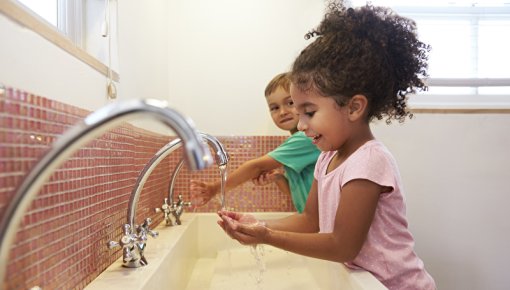Pinworms can usually be treated effectively with medication known as anthelmintics (anti-worm drugs). These include the drug mebendazole, for example. If the doctor confirms that the child has worms, you will be given a prescription. Sometimes all of the child's family members have the treatment as well.
The medication is available as a tablet to be swallowed, a chewable tablet, or a syrup that younger children can swallow too. The manufacturers recommend taking it for three days. Doctors often consider a single dose to be enough. It is taken again after two to four weeks, to get rid of all the worms and prevent a new infection.
Anti-worm drugs are usually well tolerated. If side effects occur, the most common ones are belly ache, diarrhea, gas, nausea, and vomiting.
Apart from anti-worm drugs, good hygiene is also an important part of treatment. Otherwise, the child will almost certainly keep getting worms again and again. That means that
- Wash hands regularly and thoroughly, especially before eating and after using the toilet. Parents should do this too, for instance after changing their child's diaper.
- Clean the child's bottom every day, as soon as they wake up. Do not take a bath together, just in case.
- Avoid scratching. Make sure the child doesn't scratch their bottom. If they do scratch their bottom, make sure they wash their hands properly afterwards. Wearing cotton gloves can stop worm eggs from collecting under the fingernails if children do scratch themselves without meaning to – for instance, at night. Sometimes, creams are also used to soothe the itching.
- Keep fingernails short and clean, and scrub the underside regularly using a nail brush. Make sure that the child doesn't bite their nails or put their hands in their mouth.
- Change underwear daily.
- Change bedding often. It is especially important to change the child's bedding on the days after taking the medication.
- Do not share towels. Each family member should use their own towel and flannel.
- Wash laundry in hot water. Children's underwear, pajamas, bedding and towels should be washed at temperatures of at least 40 degrees Celsius (104 degrees Fahrenheit), or hotter if possible.
Doctors sometimes recommend not shaking out bedding, to avoid throwing eggs up into the air where they can spread around the room with the dust. If you think that objects like toys might have worm eggs on them, you can clean them with soap under hot running water, or put them in the dishwasher or washing machine.
Even after successful treatment, it's still a good idea to stick to simple hygiene rules like regularly washing hands and making sure your child doesn't put their fingers in their mouth. That reduces the likelihood of getting worms again (and other illnesses).



